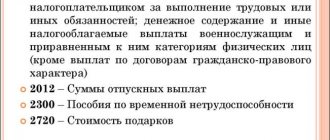Kontur.Accounting - the optimal service for the simplified tax system
Automated calculation of taxes and transactions with employees.
The simplest accounting possible. The service itself will generate KUDiR, declaration and reports. Try for free
The founders of the organization distribute profits and pay dividends every year. LLCs using the simplified tax system distribute profits in the general manner, but the calculation and payment of dividends using the simplified system have their own peculiarities. In this article we will tell you how to calculate and pay dividends using the simplified tax system.
What are dividends
Dividends are part of the profit that participants or shareholders receive from an organization upon distribution. Most often, profits are divided in proportion to shares in the authorized capital. Dividends are paid from net profit, that is, profit after paying all company taxes. The General Meeting decides on the amount and timing of payments. After this, participants are paid dividends. The period for an LLC is 60 days after the decision is made, for a JSC - 25 working days from the date on which the recipients of dividends were determined. Income can be paid no more than once a quarter.
If your organization’s authorized capital is not fully covered, there are signs of bankruptcy, or the authorized capital is greater than net assets, you cannot pay dividends.
Calculation of dividends with simplified tax system 6%
Applying the simplified “income” scheme, you can notice that the amounts of profit in accounting and tax accounting do not coincide. The single tax is levied only on the amount of income, and the expenditure part does not play a role, although costs are recorded. It is on the basis of the profit indicator, which takes into account the company's income and expenses, that dividends are paid. This profit is reflected in the balance sheet - “Retained earnings (uncovered loss).” Profit for the year is reflected in the financial results report on line 2400 “Net profit”.
Profits are distributed in proportion to the shares of participants. The charter may specify a different procedure.
Example. The company has three founders, their shares are: U1 - 30%, U2 - 30% and U3 - 40%. At the end of 2021, the organization’s net profit amounted to 800,000 rubles; at the general meeting of founders, it was decided to distribute half, i.e. 400,000 rubles.
The calculated part of the dividends will be: for Y1 = 400,000 × 30% = 120,000 rubles, Y2 = 400,000 × 30% = 120,000 rubles, Y3 = 400,000 × 40% = 160,000 rubles. The calculated dividend amounts cannot be paid to participants in this form. Before transferring dividends, you must withhold 13% personal income tax.
How to calculate the amount of dividends in simplified terms
Let's consider the practical side of the issue of determining the amount of net profit for the purpose of paying dividends to the participants of the organization. If the company kept accounting records in accordance with the requirements of regulatory documents on accounting, then resolving this issue will not cause serious problems, however, we recall that maintaining accounting records in accordance with paragraph 1 of Article 1 of Law No. 129-FZ means “an orderly system of collection, registration and generalization of information in monetary terms about the property, obligations of organizations and their movement through continuous, continuous and documentary accounting of all business transactions.”
Let's consider the methodology for calculating net profit using a conditional example. So, LLC applies a simplified taxation system, where the object of taxation is income reduced by the amount of expenses. The financial and economic activities of the company for the reporting period were reflected in the accounting records as follows:
Table 1
| Accounting | Contents of business transactions | ||
| Debit | Credit | Sum | |
| Acquisition of property: | |||
| 08 | 60 | 1 000 000,00 | Fixed assets |
| 10 | 60 | 2 000 000,00 | Materials |
| 01 | 08 | 1 000 000,00 | Commissioning |
| The costs of production activities are reflected: | |||
| 20 | 10 | 150 000,00 | Material costs |
| 60 | 51 | 900 000,00 | Paid the supplier's invoice for the supplied materials |
| 20 | 02 | 120 000,00 | Depreciation accrued |
| 60 | 51 | 1 000 000,00 | Paid the supplier's invoice for the supplied fixed assets |
| 20 | 70 | 300 000,00 | Labor costs |
| 70 | 51 | 261 000,00 | Wages paid |
| 20 | 69 | 42 000,00 | UST accrued |
| 70 | 68/NDFL | 39 000,00 | Personal income tax accrued |
| 20 | 60 | 400 000,00 | other expenses |
| 60 | 51 | 400 000,00 | Suppliers' invoice for accepted other expenses has been paid |
| Implementation: | |||
| 60 | 90 | 2 000 000,00 | Goods (works, services) sold |
| 51 | 62 | 500 000,00 | Payment received from buyers |
| 90 | 20 | 1 012 000,00 | The cost of sold work and services was written off |
| 91 | 51 | 100 000,00 | Non-operating expenses (from own profit, not accepted as expenses under the simplified taxation system) |
| 99 | 68/usn | 5 000,00 | Minimum tax charged (500,000 × 1%) |
| 99 | 91 | 100 000,00 | Financial results revealed |
| 90 | 99 | 988 000,00 | |
| 99 | 84 | 883 000,00 | The net profit of the organization is reflected |
The result of the financial and economic activities of the company is shown in the balance sheet (see Table 2).
table 2
| Account number | Opening balance | Monthly turnover | Closing balance | |||
| Debit | Credit | Debit | Credit | Debit | Credit | |
| 01 | 1 000 000 | 0 | 1 000 000 | 0 | ||
| 02 | 0 | 120 000 | 0 | 120 000 | ||
| 08 | 1 000 000 | 1 000 000 | 0 | 0 | ||
| 09 | 0 | 0 | 0 | 0 | ||
| 10 | 2 000 000 | 150 000 | 1 850 000 | 0 | ||
| 20 | 1 012 000 | 1 012 000 | 0 | 0 | ||
| 51 | 5 000 000 | 500 000 | 2 661 000 | 2 839 000 | 0 | |
| 60 | 2 300 000 | 3 4000 000 | 0 | 1 100 000 | ||
| 62 | 2 000 000 | 500 000 | 1 500 000 | 0 | ||
| 68/usn | 0 | 5 000 | 0 | 5 000 | ||
| 68/NDFL | 0 | 39 000 | 0 | 39 000 | ||
| 69 | 0 | 42 000 | 0 | 42 000 | ||
| 70 | 300 000 | 300 000 | 0 | 0 | ||
| 77 | 0 | 0 | 0 | 0 | ||
| 80 | 5 000 000 | 0 | 0 | 0 | 5 000 000 | |
| 84 | 0 | 883 000 | 0 | 883 000 | ||
| 90 | 2 000 000 | 2 000 000 | 0 | 0 | ||
| 91 | 100 000 | 100 000 | 0 | 0 | ||
| 97 | 0 | 0 | 0 | 0 | ||
| 99 | 988 000 | 988 000 | 0 | 0 | ||
| Total | 5 000 000 | 5 000 000 | 13 200 000 | 13 200 000 | 7 189 000 | 7 189 000 |
For tax purposes, the company’s income and expenses can be determined using accounting data:
Table 3
| Debit | Credit | Sum | Contents of operation |
| 51 | 62 | 500 000 | Income received in terms of payment received from the customer |
| 60 | 51 | 2 300 000 | Expenses are reflected in the amount of paid supplier invoices |
| 70 | 51 | 261 000 | Expenses are reflected in the amount of wages paid to employees |
| -2 061 000 | Identified financial result (tax base) based on the results of the tax period | ||
As we can see, in the company’s accounting there is a profit (RUB 883,000), and for tax purposes – a loss (RUB 2,061,000). It is clear that the founders of the company will not like the idea of distributing dividends from the tax base.
The difference in the final financial result for tax and accounting purposes is due to the following main factors:
- In accounting, material expenses are recognized as inventories are written off for production, and for tax purposes - upon payment to the supplier. Thus, the very fact of purchasing materials reduces profit for tax purposes;
- in accounting, depreciation of fixed assets is recognized as an expense, and for tax purposes, an expense is recognized as the full cost of the fixed asset as of the date of commissioning;
- All expenses of the organization are recognized in accounting, including those not related to its production activities. For tax purposes, the list of expenses is limited.
Accounts receivable reflected in the balance sheet lead to an increase in the company's accounting profit. At the same time, for tax purposes it will not be recognized as income, and when it is repaid in the next reporting period, it will form a tax liability of the company. In other words, accounts receivable includes a deferred tax liability. Similarly, accounts payable is the amount of deferred expenses that will be accepted in the next tax period, i.e. includes a deferred tax asset.
There are other factors due to which the amount of profit for accounting purposes will not coincide with the tax base, but it is impossible and not necessary to consider everything. However, from the above it follows that it is necessary to understand how to determine the amount of the company’s net profit for the reporting period.
When analyzing the reasons for the discrepancies between the accounting profit and the tax base of the company, the terms “deferred tax liability” and “deferred tax asset” were mentioned. These terms were put into effect by PBU 18/02 “Accounting for income tax calculations”. The purpose of adopting the aforementioned Regulations is to form the organization’s net profit in such a way that shareholders have at their disposal only that amount of net profit on which all taxes have already been accrued (paid).
It seems reasonable to apply this approach to the example under consideration. To do this, all permanent and temporary tax differences should be reflected in the accounting records, using the methodology of PBU 18/02 as a basis.
In this case, the transactions of the reporting period will be reflected in accounting as follows:
Table 4
| Accounting | Contents of business transactions | ||
| Debit | Credit | Sum | |
| Acquisition of property: | |||
| 08 | 60 | 1 000 000,00 | Fixed assets |
| 10 | 60 | 2 000 000,00 | Materials |
| 01 | 08 | 1 000 000,00 | Commissioning |
| The costs of production activities are reflected: | |||
| 20 | 10 | 150 000,00 | Material costs |
| 60 | 51 | 900 000,00 | Paid the supplier's invoice for the supplied materials |
| 68/usn | 77 | 112 500,00 | Accrued temporary difference for accepted and paid inventory items ((900,000 - 150,000) × 15%) |
| 20 | 02 | 120 000,00 | Depreciation accrued |
| 60 | 51 | 1 000 000,00 | Paid the supplier's invoice for the supplied fixed assets |
| 68/usn | 77 | 132 000,00 | Accrued temporary difference for accepted and paid fixed assets ((1,000,000 - 120,000) × 15%) |
| 20 | 70 | 300 000,00 | Labor costs |
| 70 | 51 | 261 000,00 | Wages paid |
| 20 | 69 | 42 000,00 | UST accrued |
| 09 | 68/usn | 6 300,00 | A temporary difference has been accrued for the accrued but unpaid unified social tax (42,000 × 15%) |
| 70 | 68/NDFL | 39 000,00 | Personal income tax accrued |
| 09 | 68/usn | 5 850,00 | A temporary difference has been accrued for accrued but unpaid personal income tax (39,000 × 15%) |
| 20 | 60 | 400 000,00 | other expenses |
| 60 | 51 | 400 000,00 | Suppliers' invoice for accepted other expenses has been paid |
| Implementation: | |||
| 62 | 90 | 2 000 000,00 | Goods (works, services) sold |
| 51 | 62 | 500 000,00 | Payment received from buyers |
| 68/usn | 77 | 225 000,00 | A temporary difference has been accrued for accrued but unpaid sales of goods (work, services) ((2,000,000 – 500,000) × 15%) |
| 90 | 20 | 1 012 000,00 | The cost of sold work and services was written off |
| 91 | 51 | 100 000,00 | Non-operating expenses (from own profit, not included in expenses during “simplification”) |
| 99 | 68/usn | 15 000,00 | A permanent tax liability has been accrued for expenses not accepted under the “simplified” procedure (100,000 × 15%) |
| 99 | 68/usn | 5 000,00 | Minimum tax charged (500,000 × 1%) |
| 99 | 91 | 100 000,00 | Financial results revealed |
| 90 | 99 | 988 000,00 | |
| 99 | 84 | 734 800,00 | The net profit of the organization is reflected |
| Transformation: | |||
| 99 | 68/usn | 133 200,00 | A conditional expense was accrued for the profit received in accounting (888,000 × 15%) |
| 09 | 68/usn | 309 150,00 | The loss received from the simplified taxation system is carried forward (2,061,000 × 15%) |
As a result, we get the balance sheet:
Table 5
| Account number | Opening balance | Turnover for the period | Closing balance | |||
| Debit | Credit | Debit | Credit | Debit | Credit | |
| 01 | 1 000 000 | 0 | 1 000 000 | 0 | ||
| 02 | 0 | 120 000 | 0 | 120 000 | ||
| 08 | 1 000 000 | 1 000 000 | 0 | 0 | ||
| 09 | 321 300 | 0 | 321 300 | 0 | ||
| 10 | 2 000 000 | 150 000 | 1 850 000 | 0 | ||
| 20 | 1 012 000 | 1 012 000 | 0 | 0 | ||
| 51 | 5 000 000 | 500 000 | 2 661 000 | 2 839 000 | 0 | |
| 60 | 2 300 000 | 3 400 000 | 0 | 1 100 000 | ||
| 62 | 2 000 000 | 500 000 | 1 500 000 | 0 | ||
| 68/usn | 469 500 | 474 500 | 0 | 5 000 | ||
| 68/NDFL | 0 | 39 000 | 0 | 39 000 | ||
| 69 | 0 | 42 000 | 0 | 42 000 | ||
| 70 | 300 000 | 300 000 | 0 | 0 | ||
| 77 | 0 | 469 500 | 0 | 469 500 | ||
| 80 | 5 000 000 | 0 | 0 | 0 | 5 000 000 | |
| 84 | 0 | 734 800 | 0 | 734 800 | ||
| 90 | 2 000 000 | 2 000 000 | 0 | 0 | ||
| 91 | 100 000 | 100 000 | 0 | 0 | ||
| 97 | 0 | 0 | 0 | 0 | ||
| 99 | 988 000 | 988 000 | 0 | 0 | ||
| Total | 5 000 000 | 5 000 000 | 13 990 800 | 13 990 800 | 7 510 300 | 7 510 300 |
As can be seen from the balance sheet, the accounting net profit turned out to be completely different from the first time. However, it is the amount of profit obtained in this way that characterizes the real results of the financial and economic activities of the company, i.e. takes into account deferred tax liabilities and assets, as well as permanent tax differences.
However, it would not be amiss to mention the following circumstances.
Firstly, the requirements of PBU 18/02 may not be fulfilled by small enterprises, and this includes all organizations that use the “simplified approach”. Secondly, compliance with the requirements of PBU 18/02 in practice will significantly increase the volume of accounting work.
Therefore, we consider it possible to apply a simplified methodology for calculating net profit . It is as follows.
Tax differences are not accounted for, i.e. the reflection of transactions in accounting corresponds to those shown in Table 1 and Table 2. Based on the results of the reporting period, accounting profit is adjusted, namely:
- We adjust the amount of accounting profit by the amount of future tax liabilities (which will arise when paying off receivables and payables). To do this, the amount of profit according to accounting is multiplied by the tax rate. In our example – 888,000 × 15% = 133,200.
- We adjust the amount of accounting profit by the amount of tax liabilities for expenses that are not accepted for tax purposes. In our example, the amount of expenses not accepted for tax purposes is assumed to be 100,000 rubles. Then it’s obvious: 100,000 × 15% = 15,000.
The resulting values (133,200 + 15,000 = 148,200) are the amount of the company’s deferred tax liabilities, which should be reflected in the balance sheet.Thus, the accounting records should reflect the adjustments made with the following accounting entries (see Table 6):
Table 6
Accounting Contents of business transactions Debit Credit Sum 99 68/usn 133 200,00 A conditional expense was accrued for the profit received in accounting (888,000 × 15%) 99 68/usn 15 000,00 A permanent tax liability has been accrued for expenses that are not accepted under the simplified taxation system (100,000 × 15%) 68/usn 77 148 200,00 Deferred tax liability accrued Note that as a result of the adjustment, the amount of accounting profit did not change, i.e. remained the same as when tax differences were reflected in accounting using a methodology similar to that established by PBU 18/02.
Next, you should draw up a regular balance sheet and profit and loss account, which should be presented to the general meeting of the company's participants.
Taxation of listed dividends on the simplified tax system
1. Dividends accrued to an individual
Dividends transferred to a company participant are subject to personal income tax. In this case, the organization is a tax agent. Withhold personal income tax at 13% for residents of the country and 15% for non-residents. If in 2021 and 2022 the amount of dividends exceeds 5,000,000 rubles, then the excess amount will have to be taxed at a rate of 15%, even for residents. In this case, from 2023, not only the amount of dividends will be taken into account, but also other income.
There is no need to pay additional insurance premiums for dividend payments. Similar rules apply if the recipient of the dividends is an individual entrepreneur using the simplified tax system, unified agricultural tax or patent.
Payment of dividends under the simplified tax system of 6% in favor of an individual occurs in the following order:
Example. Matryoshka LLC uses the simplified tax system “Income”. Its only founder is Moshkin E.V. decided to distribute net profit and accrue dividends in the amount of 70,000 rubles. Moshkin is a tax resident of the Russian Federation. Dividends are scheduled to be paid on May 15.
Since Moshkin is an individual resident of the Russian Federation, his income is subject to personal income tax at a rate of 13%. The tax base was 70,000 rubles.
70,000 × 13% = 9,100 tax amount
The amount of dividends transferred to Moshkin, minus personal income tax, will be 70,000 – 9,100 = 60,900 rubles. The withheld tax amount must be transferred to the budget no later than May 16.
All types of deductions when calculating dividends are not provided.
Important ! The amount of income tax that was withheld from dividends received by your organization from another is taken into account when calculating personal income tax on dividends paid to individuals. This only works for residents. The formula is as follows:
N = K × CH × (D1 - D2), where:
- N - amount of tax to be withheld;
- K is the ratio of the amount of dividends subject to distribution in favor of the recipient of dividends to the total amount of distributed dividends;
- Сн - tax rate;
- D1 - the total amount of dividends to be distributed in favor of all recipients;
- D2 - the total amount of dividends received from other organizations.
2. Dividends accrued to organizations
Not only an individual, but also an organization can have a share in the authorized capital of a company using the simplified tax system. When paying dividends to an organization, withhold income tax. Even if the organization is in the special regime of the simplified tax system or unified agricultural tax, income tax still must be paid.
The income tax rate on dividends to Russian organizations is 13% in the standard case. If the participation interest is 50% or more, and the continuous period of ownership exceeds 365 days, then the rate is 0%. If the recipient is a non-resident legal entity, then the rate is 15% (another amount may be established by international agreement).
If the amount of dividends you received is greater than the amount you must pay, then no withholding tax is calculated. The formula for calculation is the same as for individuals: H = K × Cn × (D1 - D2).
An organization using the simplified tax system mistakenly included dividends in income: how to correct the situation
Organizations using the simplified tax system do not take into account the income listed in clause 1.1 of Art. 346.15 Tax Code of the Russian Federation. Such income includes the income of an organization, subject to corporate income tax at the rates provided for in paragraphs. 1.6, 3 and 4 tbsp. 284 of the Tax Code of the Russian Federation (clause 2, clause 1.1, article 346.15 of the Tax Code of the Russian Federation). Clause 3 of Art. 284 of the Tax Code of the Russian Federation provides for tax rates, in particular, for income received in the form of dividends by Russian organizations.
Income tax is calculated on dividends, withheld from the amount of dividends and transferred to the budget by the tax agent - the Russian organization that is the source of payment of dividends (clause 3 of Article 275 of the Tax Code of the Russian Federation).
That is, your organization, located on the simplified tax system, receives from a Russian organization - tax agent the amount of dividends minus tax; this income is not subject to re-taxation.
Thus, an organization using the simplified tax system does not take into account in its income for the purposes of calculating the tax paid when applying the simplified tax system, the amount of dividends received.
The procedure for filling out a tax return for tax paid in connection with the use of the simplified tax system (hereinafter referred to as the Declaration under the simplified tax system) (approved by order of the Federal Tax Service of Russia dated February 26, 2016 N ММВ-7-3/ [email protected] ) does not provide for the reflection in it of income that is not taken into account when determining the object of taxation, including in the form of dividends received. Based on the description of the situation, an error was made when filling out a declaration under the simplified tax system (the income included the amount of dividends received from a Russian organization).
If a taxpayer discovers inaccurate information in the tax return submitted to the tax authority, as well as errors that do not lead to an understatement of the amount of tax payable, the taxpayer has the right to make the necessary changes to the tax return and submit an updated tax return to the tax authority.
You can submit an updated declaration for a refund (offset) of the overpayment within 3 years from the date of transfer of the tax. The tax authority will not return overpayments for longer periods (Article 78 of the Tax Code of the Russian Federation).
The tax under the simplified tax system is federal, so offset is possible against future payments for this or other federal taxes. By overpayment you can pay off debts on these taxes, including penalties and fines (clause 7 of article 12, subclause 2, clause 2 of article 18, clause 1 of article 78 of the Tax Code of the Russian Federation). You have three years to offset the tax from the date you paid the excess tax (Clause 7, Article 78 of the Tax Code of the Russian Federation).
Since your tax overpayment arose due to an error in the declaration, before offset it is necessary to submit updated declarations (clause 4 of article 78 of the Tax Code of the Russian Federation, clause 1 of article 81 of the Tax Code of the Russian Federation).
The tax authority will conduct a desk audit of the updated declarations, the inspection period is three months from the date of filing the declaration (clause 2 of Article 88 of the Tax Code of the Russian Federation). To offset the overpayment against future payments, you must submit an application for offset to the tax authority. An application for offset of the amount of overpaid tax (fee, penalty, fine) should be submitted to the tax authority in the form approved by Order of the Federal Tax Service of Russia dated February 14, 2017 N ММВ-7-8/ [email protected] (Appendix No. 9).
The amount of overpaid tax returned to the organization from the budget is not taken into account when determining the tax base in the form of income, since this amount is not an economic benefit in relation to clause 1 of Art. 41 of the Tax Code of the Russian Federation (Letter of the Ministry of Finance of the Russian Federation dated June 22, 2009 N 03-11-11/117 (sent by Letter of the Federal Tax Service of Russia dated July 7, 2009 N ShS-17-3 / [email protected] )).
Thus:
- Income in the form of dividends from a Russian organization is subject to tax at the source of payment - the tax agent and is not included in the tax return paid under the simplified tax system for the organization receiving the dividends;
- Overpayment of tax under the simplified tax system can be offset; to do this, you must submit updated declarations and an application for offset;
- Updated declarations that correct errors that led to overpayment of tax to the budget must be submitted within three years from the date of payment of the specified amount , until the moment of filing an application for a refund (offset) of the overpaid tax (Clause 7 of Article 78 of the Tax Code of the Russian Federation) . Otherwise, such a refund (credit) may be denied.
Get expert advice
according to your situation and get expert advice.
Ask a Question
Ask a Question










